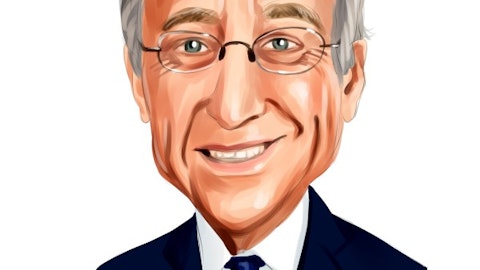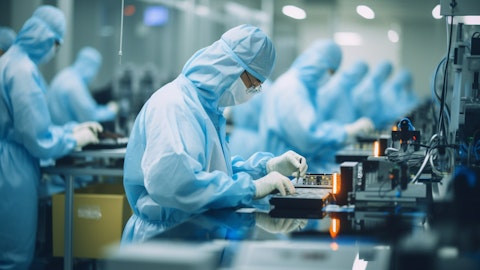I will categorize the environment in China this time that I went to much better than what I saw in 2023, in the sense that there seems to be teams reenergized about maybe what’s happening in terms of the stimulus and how the teams continue to leverage our technology into other end markets that they see some good pockets of growth. I was very encouraged to see how the team continues to navigate that difficult market by being very nimble and agile in terms of pivoting to those areas of good growth.
Vik Kini: Yes Nigel on the second part of your question about the growth cadence first half versus second half. Yes probably a couple of factors I’d point to. One being, first and foremost, we do walk into the year with a still healthy backlog, including a good percentage of that that’s longer cycle in nature. So that obviously gives us some good visibility into the back half of the year, when a lot of those projects tend to more naturally ship. And then yes, I do think there’s a lot of truth in the statement you made about, clearly, comps gets a little bit more moderate in the back half of the year across the Board, but clearly whether it be China as well as the life sciences side of the equation on the PST business. So I think it’s a couple of different factors. But again, like we said before, we think the phasing of delivery of revenue and earnings is actually very consistent in ’24 versus what you’ve seen historically.
Nigel Coe: My follow-up question is, the strength in European compressor orders is remarkable considering what’s going on in the economy there. If you had to rank order these three, Scope 1 emission targets, CO2 pricing and high energy prices, obviously, IRX on top of that, but if you have to rank those three, what would you say is the most important factor?
Vicente Reynal : I would say, high energy prices and Scope 1, which are I mean kind of interrelated one with the other one. But yes, I’d say high energy prices, number one, Scope 1 in terms of targets that many of the companies have put out there and then the third will be around the CO2.
Operator: Your next question comes from Joe Ritchie with Goldman Sachs.
Joe Ritchie : A nice sense of the year. Obviously, incremental margins were great. You hit your margin targets two years ahead of time. You think about this ITS business now, and I know that you have this incremental margin target for the year of 35 to 40. I guess just to — I’m just curious, like how much of that do you — would you say is volume dependent at this point? I know IRX is all about continuous improvement but just your ability to just deliver continued margin expansion if the volumes ultimately turn out to be weaker than expected.
Vicente Reynal : Joe, I would say that, I mean even when you think about our guidance, I mean, it just shows that lower growth but still generating that very good margin. And that’s driven by the activities that we have done call it i2V, also a price and even after market. So I think those are three core initiatives that we have continued to do really well. We always said that the ITS was very well ahead, because that was part of a integration between Gardner Denver and IR on how we did those three initiatives prioritize there. But I can tell you, I mean the PST team like even two weeks ago, they had like a worldwide i2V event and it was just highly, highly encouraging to see how our new leader is just driving that type of methodology into a segment that in the past — they did it, but not in a way that we’d like that to be done.
In addition, I think what you saw here in the fourth quarter is that, we took some proactive surgical — what we call surgical restructuring at the end of the year. Again, that’s a prudency for us to continue to protect the P&L. I think that’s controlling what we can control and taking the actions to ensure that we can deliver that solid margin improvement.
Joe Ritchie : Look, it sounds like you’ve been on the road slow trotting the last several weeks. I’m curious, just from a regulatory standpoint, are there any kind of changes in regulations that you guys are seeing across any particular region that might be impacting your business or could impact your business going forward in the next we’ll call it next 12 to 24 months?
Vicente Reynal : I mean, nothing that I would say of significant dramatic change that is new. I mean, we know about clearly the energy efficiency standards that are coming into effect by the federal government in the U.S., there’s some refrigeration standards that will drive basically our air treatment business. I would be it in a positive way, driven first in Europe and then in the U.S. too as well. But those are kind of known that we have known for a little while and but they’re not new.
Operator: Your next question comes from Steve Volkmann with Jefferies.
Steve Volkmann : Maybe just a couple of longer term ones here. Just kind of going back to orders in backlog, now that the world is sort of normalizing again over some period, should we expect backlog to decline or do you think it’s kind of at the rate that it should be going forward?
Vicente Reynal: I’ll categorize that. I mean, so good news is that clearly we’re still a pretty high backlog, which is encouraging to see. I think over time perhaps yes, it will get normalized. But again, I think when we think about the business that if we continue to get this book to build of one of approximately one that we continue to expect to see here in 2024, I think backlogs seem to be continuing at a pretty higher level than what we have done historically.
Vik Kini: The other thing I would say there is, with the amount of, as they said with some of the longer cycle, we do fundamentally feel that compared to years in the past, there is just a higher amount of our backlog that’s the longer cycle projects, which then clearly leads to the level of backlog you have now. So I think that you have seen a little bit of a structural change in the composition of the backlog as compared to more historic times.
Steve Volkmann : And then switching gears a little bit, companies that are acquisitive and sort of have this flywheel that you guys have occasionally something comes over the transom that isn’t quite what you thought it was going to be? And you may have a little disappointment in some piece of some business or something? So I’m just curious, any lessons learned, anything like that happening? And more importantly, should we expect some level of divestitures to be kind of part of this machine as we go forward?
Vik Kini: So, you’ve seen us now since the merger done, we’ve done over 40 transactions and obviously not all of them have been a hundred percent the same. But what we would say here is, and we’ve acknowledged this before, probably the ones that maybe slightly below expectations comparatively speaking are probably the ones where IRX and that integration process probably didn’t get embedded from day one, if not before. So if the lesson learned here is, we’ve got a playbook whether it’s an ITS acquisition or a PST acquisition, we’re going to continue to deploy that playbook on the IRX side because we fundamentally view that as the catalyst for success in terms of the integration and really embedding those businesses within the core.
Vicente Reynal: Yes, I mean, the only thing that I’ll add to that too as well is that, I think we said this before but my staff meeting, which happens typically on Fridays it’s run as an IDM part of the IRX and one of the areas of focus is basically we have a dashboard of all the M&As as that are getting integrated, where we can clearly see if there’s any issues or gaps. And that was an implementation that we did quite a few months ago, I would say 18 months ago as we saw maybe some businesses that were not properly integrated. So I think it’s just part of that as Vik said, continuous improvement, good evolution and having the news travel fast, so that we can react and course correct if something is not going the right way.
Operator: Your next question comes from Chris Snyder with UBS.
Chris Snyder : I wanted to also ask on the M&A engine and maybe a more high level one. So revenue in 2024 is going to be about 40% above 2021. Does that make it more difficult for the company to add this 400 to 500 basis points M&A contribution every year? And does it change anything around the process of doing so? Just as the numbers have, again, I guess gone 40% bigger versus three years ago to keep that same run rate.
Vicente Reynal : Chris, I would say that, I mean, it has become more difficult. I would say that when you think about it back in 2021, I think our addressable market, back in the Investors Day, we said it was maybe what $25 billion — but it was $25 billion, $30 billion. And you saw our most recent Investors Day, our addressable market being $55 billion. Clearly, when we make an acquisition, we look at it also from the entrepreneur perspective of are we able to increase the addressable market and by increasing the addressable market. We’re doing it in a highly fragmented market that gives us a greater pool of transactions to be able to be acquired. We’re always very thoughtful on this kind of flywheel of the M&A engine as to just being one that is just an ongoing engine that can continue to grow.
I think that’s in terms of statistics and data points that’s why we track number of transactions by tollgate and with the probability. I think the cadence of that M&A, it’s pretty solid. In terms of change in the process, I mean nothing that I will say has been dramatic change. We continue to always make some tweaks and improvements. I think about a year ago, we spoke about how we look at about 100 micro trends and that leads into new M&A transactions that we can actually possibly do. We’re always trying to continue to evolve our process to make it better on an ongoing basis. Changing the process, yes, because we are always continually improving the way we do things.
Chris Snyder : And then maybe just a follow-up on productivity and efficiency of the business. Obviously, margins have been really strong here the last three to four years. Do you feel like the efficiency of manufacturing has returned to pre-COVID levels? Obviously, there’s a lot of disruption, coming out of the pandemic, which I’m sure was a headwind to margins in some capacity. Do you feel like that is fully back at this point?
Vicente Reynal : I mean, I don’t think so. Only because I mean, I think still there’s a little bit of supply chain disruption here and there that happens, right? And so giving you, for example, I mean, the situation with the Red Sea, the situation in the Panama Canal, I mean, a lot of that creates supply chain disruption and we as a company that we’re so global and being so good in terms of assembly, anytime oil supply chain disruption, it creates inefficiencies in the factory. I would say that, it is not back to the normal stability that we have seen maybe pre-COVID. That’s my view. I think also we are pretty critical, Chris, in terms of how we want to continue to improve our factories and our operations. Is that lean mindset that of continuous improvement that always view as that — we always have to do better than what we did in the past.




